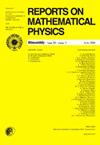The nonisospectral super integrable hierarchies associated with Lie superalgebra S L (1, 2)
IF 1
4区 物理与天体物理
Q3 PHYSICS, MATHEMATICAL
引用次数: 0
Abstract
Based on Lie superalgebra sI(1, 2) and the TAH scheme, we derive (1+1)-dimensional and (2+1)-dimensional nonisospectral integrable hierarchies and the corresponding super Hamiltonian structures. At the same time, we construct a generalized Lie superalgebra sI(1, 2), and apply it to (1+1)-dimensional and (2+1)-dimensional integrable systems. Finally, we discuss the super Hamiltonian structures of (1+1)-dimensional and (2+1)-dimensional integrable hierarchies associated with Lie superalgebra sI(1, 2).
与李超代数SL (1, 2) 相关的非等谱超可积分层次结构
基于Lie超代数sI(1, 2)和TAH方案,我们推导了(1+1)维和(2+1)维非等谱可积分层次和相应的超哈密顿结构。同时,我们构建了广义的李超代数 sI(1,2),并将其应用于(1+1)维和(2+1)维可积分系统。最后,我们讨论了与李超代数GsI(1, 2)相关的(1+1)维和(2+1)维可积分层次的超哈密顿结构。
本文章由计算机程序翻译,如有差异,请以英文原文为准。
求助全文
约1分钟内获得全文
求助全文
来源期刊

Reports on Mathematical Physics
物理-物理:数学物理
CiteScore
1.80
自引率
0.00%
发文量
40
审稿时长
6 months
期刊介绍:
Reports on Mathematical Physics publish papers in theoretical physics which present a rigorous mathematical approach to problems of quantum and classical mechanics and field theories, relativity and gravitation, statistical physics, thermodynamics, mathematical foundations of physical theories, etc. Preferred are papers using modern methods of functional analysis, probability theory, differential geometry, algebra and mathematical logic. Papers without direct connection with physics will not be accepted. Manuscripts should be concise, but possibly complete in presentation and discussion, to be comprehensible not only for mathematicians, but also for mathematically oriented theoretical physicists. All papers should describe original work and be written in English.
 求助内容:
求助内容: 应助结果提醒方式:
应助结果提醒方式:


